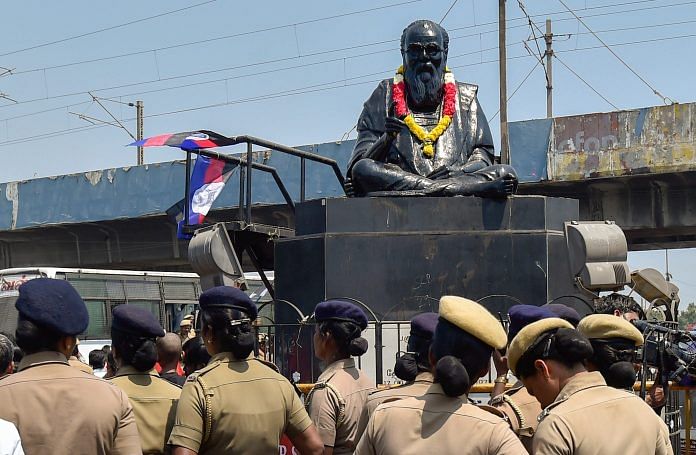Thank you dear subscribers, we are overwhelmed with your response.
Eugene F. Irschick in his book, ‘Political and Social conflicts in South India’, has commented that British colonial officials in India, during 19th-20th century, sought to encourage the growth of ‘Non Brahminical movement’ in South India. The well known ‘Divide and Rule’ policy of British was not limited to religion only. With time it realised that caste-based mobilizations can be very conducive in the Dravidian land. The primary reason was a ‘feeling of injustice’ in the non-Brahminical leaders, who believed that despite having a population-wise majority, their share in the administration was abysmally low. For instance, in 1912, in Madras Presidency, among 140 Deputy Collectors, 77 were Brahmins.
Rise of Non-Brahmin leaders
With the support of the British, leaders like T.M. Nair, P.T. Chetty and EV Ramaswamy rose rapidly in the political spectrum. They started connecting ‘anything’ to ‘everything’ to Brahmins and aggressively opposed it. They opposed Annie Besant and her ‘Home Rule Movement’ because they believed that it would benefit the Brahmins. They also campaigned against the Non-Cooperation Movement. They adopted a hostile stance towards the Congress [and Gandhi] after charging it of being a Brahmins dominated organization. Intentionally or unintentionally, they went to the extent that they declared 15th August, 1947 [Independence Day] as ‘a day to mourn’.
The reason of Brahmins-domination
The so-called ‘non-Brahmin leaders’ were not wrong in their analysis of Brahmins domination in the administrative framework. But instead of finding the real reason behind this, they started blaming the ‘mere existence of Brahmins’ for the exclusion of non-Brahmins from the administration. The real reason was- ‘the division of labour’, which was the basic foundation of the caste system. Some castes were involved in business (Baniya), some in agriculture (Jat, Yadav), similarly Brahmins were involved in the academics- that is, to read and recite Vedas, Upanishads etc.
When British came, they brought English with them. Naturally, those involved in academics started learning English, and became the 1st choice of British while offering a job. Point to remember is that, it was the British who were imparting the English education to Brahmins and then employing them. It was the responsibility of theirs to ensure that education is given in an inclusive manner. But they cleverly shifted the blame to Brahmins. The leaders like EV Ramaswamy Naicker and V. Veeramani failed to understand that the real aim of the British was not to share the pain of non-Brahmins, but to ‘Divide and Rule’. They knew that Brahmins were not more than 3% in Tamil Nadu, and it is the non-Brahmins that constitute the majority.
Being a Brahmin is anti-Tamil
The earlier attempts of division didn’t garner any specific response from the public. The non-Brahmin Tamilians knew that the Tamil Brahmins’ population was very marginal in the Dravidian landscape. They were also aware of the natural reasons of Brahmins domination in the administration and that’s why they outrightly rejected the provocative calls such as ‘kill Brahmins’. This was one of the reasons that ‘anti-Brahmin’ leaders like T.M. Nair and P. Ramarayaningar were defeated in the 1916 elections to the imperial legislative council.
Then a new strategy was adopted by the political leaders (previously non-Brahmin leaders), whose ultimate aim was to consolidate their voters. They established the South Indian People’s Association (SIPA) to publish English, Tamil and Telugu newspapers to publicize grievances of non-Brahmins. In a way Brahmins became a symbol of Hindi (including Tamilian Brahmins). Then came the turn of the temples. Brahmin priests were threatened to recite hymns in Tamil instead of Sanskrit. Again, Sanskrit was associated with Brahmins. And the old aged Sanskrit Shlokas became a symbol of ‘anti-Tamilism’. The Sanskrit written texts like Ramayana and Mahabharata were discarded for being anti-Tamil.
In 1956, EV Ramaswamy carried a ‘juloos’ with a picture of Lord Rama and then burnt it. The idols of Lord Ganesha were broken in full public spare. They blatantly criticized ‘Alvars’ and ‘Nayannars’. They developed their own theory and said that all these Gods and Saints were connected with the ‘Aryan culture’, which is subjugating the ‘Dravidian culture’. (Point to remember is that all this Aryan theory was discarded by the scholars like Dr B.R. Ambedkar). In this way, they touched the sentiments of the Tamilians and made them believe that whatever happening outside their region is anti-Tamil and those 3% TamilBrahm are responsible for this.
It all started with targeting Brahmins, who were portrayed as a symbol of pro-Hindi, pro-Sanskrit, pro-Sanatan, pro-Aryan and anti-Tamil, anti-Dravidian. The recent remark of Udhayanidhi Stalin, ‘to eradicate Sanatan Dharma’, is not new. It is a time-tested political tactic of DMK and other similar parties to consolidate their voters.
These pieces are being published as they have been received – they have not been edited/fact-checked by ThePrint.

